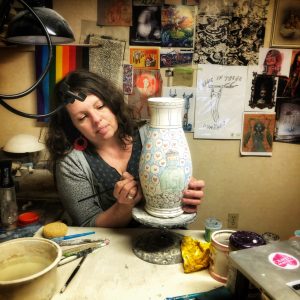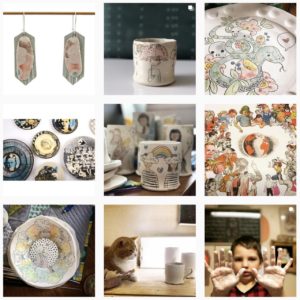Apprenticeship
In 2004 we started an apprenticeship program at Mill Creek Pottery
with the idea creating a symbiotic experience. In many ways I designed
the program to offer the experience I would have liked to have had when I
was trying to find my voice in clay. The apprentices play a vital role
in the success of the pottery allowing for more opportunities to
travel, create and learn.
As of 2013 I have had the pleasure to work with 10 apprentices, they are:
Past apprentices have gone on to residencies at the Archie Bray
Foundation, Taos Clay, and Greenwich House Pottery. Some have attended
graduate programs in ceramics, while others have simply continued in the
field. It does not surprise me that the apprentices have remained in
ceramics, as a dedication to the field is a requirement of the program.
In exchange for 15 hours a week of labor, I offer facilities,
materials, opportunity and guidance. Chores you might be doing any
given week include sanding and shipping pottery, moving or splitting
wood, lawn care, inventory, photographing and web store updates, or
giving tours and explaining the process. Apprentices facilitate the
making of my work, but do not make my work.
Facilities:
At Mill Creek Pottery we have three distinctly different wood fired
kilns, and two electrics kilns. We also have the materials for
apprentices to build and fire test kilns. The studio has a kick wheel
and an electric wheel for apprentices to use. I prefer to have two
apprentices at a time, which allows for more firing possibilities and a
small but lively studio community.
Materials:
I order several clay bodies from Continental Clay, some are my own
recipes while others are commercially available. The apprentices usually
use my own clay bodies for their work, but I am open to ordering dry
materials if an apprentice wants to test new clays. In many ways I see
Mill Creek Pottery as a woodfire research institute, so testing clays
and innovations in kiln design interest me. Of late, I have started to
encourage apprentices to publish and I may co-author articles with
future apprentices.
Opportunities:
In addition to the day in out rhythms often studio potter, I travel
and teach workshops, participate in tremendous sales with other potters
from around the country. In 2012 apprentices and I traveled to Montana
to build a kiln for the Archie Bray foundation, future kiln building
opportunities are already in the works. I sell work at Demarest (The
Art School at Old Church) a show curated by Karen Karnes, St. Croix
Pottery Tour which is the most amazing and heartening pottery sale in
the U.S., and at the ArtStream trailer at NCECA. The quality and
breadth and experience of the other potters at those sales becomes a
huge opportunity for networking, critique and conceptual fodder, not to
mention the chance to purchase some of the best pottery in the U.S.
Guidance:
I believe art pottery is different than craft pottery in that it has a
core concept it explores and communicates. My goal is for apprentices
to develop their own voice in clay, I expect them to define and clarify
not only a voice but a message in their work. This is mostly done by
making a lot of work combined with constant critique, suggestions,
conversation, and questions. We do schedule formal critiques after
firing but it is the daily process that seems more effective. I expect
apprentices to be prolific. The second component to the guidance is
career based. An undercurrent of the apprenticeship is to teach
methods to promote establish and sustain the life of the full time
artist.
I expect apprentices to invest themselves in the success of Mill
Creek Pottery, as I am invested in the success of each apprentice. A
sense of ownership and pride of place is an important ingredient to a
successful time here. I look for apprentices who are hard working,
thoughtful and open to learning, eager and respectful. Organizational
skills are appreciated.
Please note that I do not provide housing, nor meals. In the past
apprenticeshave rented inexpensive apartments or a room with a local
family. Some have held part time jobs, or used saved money as an
educational investment to spend more time in the studio. We do host an
apprentice sale and there are some opportunities to sell work, but it
doesn’t amount to a lot of money. People who are interested in an
inexpensive studio space to make a lot of work to sell should not apply.
If you are interested in the apprenticeship you should email me and
begin the conversation. I ask for a year commitment with the option to
extend. Because the studio space is shared and because apprentices
work closely with my family finding a good fit is vital. Living in
rural Wisconsin and wood firing is not for everyone, nor is my teaching
and work style.
To apply please email me [email protected], with a letter of intent, and
5-10 images of your current work








Thanks Ceramist Simon Kevin for giving people opportunity to learn from you.
Am interested in apprentiship with you but I wonder if there is any restrictions for some one as me who lives in Nigeria to come over as an apprentice.
I have a background of ceramisc as an artist.
My question and request is, would you accept an apprentiship application from me in Nigeria. ?